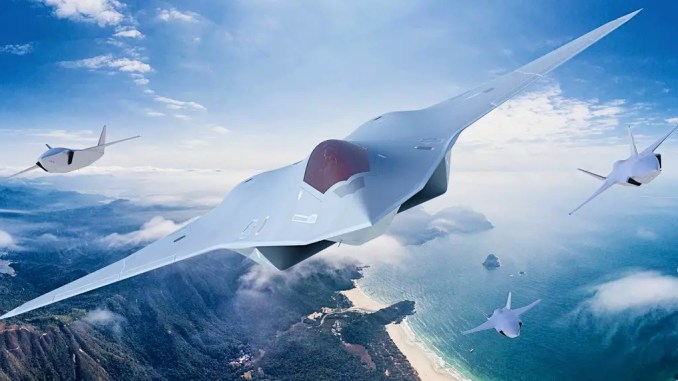
Air Force Secretary Frank Kendall revealed details about the highly classified project and the closely related Collaborative Combat Aircraft program.
Three years ago, the then Assistant Secretary of the Air Force for Acquisition, Technology and Logistics, Dr. Will Roper, announced that the U.S. Air Force had secretly designed, built and flown a full-scale prototype of a new generation fighter aircraft as part of the Next Generation Air Dominance (NGAD) program. Now, Air Force Secretary Frank Kendall revealed that a secret, multi-agency X-plane program paved the way for NGAD.
The new details were released by Kendall at the Politico Defense Summit on Nov. 14, 2023, where he was asked which are, in his opinion, the most exciting aspects of the NGAD program. Kendall recalled that in 2014, when he was Under Secretary of Defense for Acquisition, Technology and Logistics, “The Dominance Initiative” study was commissioned to DARPA (Defense Advanced Research Projects Agency).
This study recommended the successor of the F-22 Raptor to be accompanied by a “family of systems”, resulting in the Next Generation Air Dominance X-plane program being launched in 2015. The program, funded for about one billion dollars equally split by Air Force, Navy and DARPA, “produced some prototypes that were successful demonstrating the technologies we need,” said Kendall.
It is not clear if Kendall refers to the same full-scale flight demonstrator mentioned by Roper in 2020 or if these prototypes explored new advanced technologies that later merged in that demonstrator. The latter explanation appears to be the most likely, as the Secretary added NGAD is currently structured as “the combination of aircraft – a crewed aircraft [and] unmanned aircraft – that will have some of those technical characteristics we demonstrated could be done”.
“This family of systems approach we’re taking – also in the mix [is] our new weapons like the JATM, Joint Advanced Tactical Missile, which we’ll get into production in the next few years – [will create] a very formidable next generation, air dominance set of capabilities,” Kendall said. “I think when we get that package filled, I’m really looking forward and excited about seeing that come to life.”
A U.S. Marine Corps XQ-58A Valkyrie, highly autonomous, low-cost tactical unmanned air vehicle, conducts its first test flight with a U.S. Air Force F-16 Fighting Falcon aircraft assigned to 96th Test Wing at Eglin Air Force Base, Fla., Oct. 3, 2023. (U.S. Air Force photo by Master Sgt. Tristan McIntire)
” data-medium-file=”https://i0.wp.com/theaviationist.com/wp-content/uploads/2023/11/NGAD_X-Planes_Program_2.jpeg?fit=460%2C307&ssl=1″ data-large-file=”https://i0.wp.com/theaviationist.com/wp-content/uploads/2023/11/NGAD_X-Planes_Program_2.jpeg?fit=706%2C472&ssl=1″ decoding=”async” class=”size-large wp-image-84106″ src=”https://zephyrnet.com/wp-content/uploads/2023/11/secret-x-plane-program-explored-future-tech-for-next-generation-air-dominance-program-1.jpg” alt width=”706″ height=”472″ srcset=”https://zephyrnet.com/wp-content/uploads/2023/11/secret-x-plane-program-explored-future-tech-for-next-generation-air-dominance-program-1.jpg 706w, https://zephyrnet.com/wp-content/uploads/2023/11/secret-x-plane-program-explored-future-tech-for-next-generation-air-dominance-program-2.jpg 460w, https://zephyrnet.com/wp-content/uploads/2023/11/secret-x-plane-program-explored-future-tech-for-next-generation-air-dominance-program-3.jpg 128w, https://zephyrnet.com/wp-content/uploads/2023/11/secret-x-plane-program-explored-future-tech-for-next-generation-air-dominance-program-4.jpg 768w, https://i0.wp.com/theaviationist.com/wp-content/uploads/2023/11/NGAD_X-Planes_Program_2.jpeg?w=1024&ssl=1 1024w” sizes=”(max-width: 706px) 100vw, 706px” data-recalc-dims=”1″>
New details were also released about the Collaborative Combat Aircraft (CCA) program, which won’t start until the fiscal 2024 defense bill is passed. The unmanned CCA will be controlled by the NGAD aircraft, allowing both manned and unmanned platforms to fight as a formation. The program will benefit from all the past and current work being done with autonomy and unmanned aircraft.
Kendall defined the CCA program, which is expected to receive $5.8 billion in funding over the next five years, as one of the most important programs about to start. Without further delays, the production of a first increment of CCA could start around 2028.
As already reported, the U.S. Air Force wants to procure 200 NGAD fighters along with 1,000 CCA that will cooperate in the “loyal wingman” role with the sixth-generation combat aircraft. While each NGAD aircraft is expected to hundreds of millions of dollars, the CCA are designed to cost “in the order of a quarter or a third” of the current unit cost of an F-35.
Considering the average unit price for F-35s in the latest production lots is around $82.5 million, the CCA’s price could be between $20.6 million and $27.5 million. This is less than the price of a MQ-9 Reaper, which costs roughly $32 million. Even if the cost is “small”, the CCA are not considered expendable or attritable, but rather “systems that you can accept losses of a fraction of them and not have a big operational impact”.
The Air Force is still defining the right balance in terms of requirements for the CCA program, such as the range and payload characteristics that need to be consistent with the operational concept of the drones either flying ahead of or accompanying crewed fighters during their missions. An aspect already clear is that the CCA will be modular, with some carrying weapons and some carrying other systems.
This aspect would complicate targeting by an adversary, as it wouldn’t be able to determine which drones are armed and which aren’t. Runway independence is also being considered for an improved survivability. According to Kendall, the industry already provided different competing designs, and the Air Force is aiming to be able to field the first CCA quickly and in reasonable quantities and then moving to the new iteration without the long times usually required to develop new manned aircraft.
- SEO Powered Content & PR Distribution. Get Amplified Today.
- PlatoData.Network Vertical Generative Ai. Empower Yourself. Access Here.
- PlatoAiStream. Web3 Intelligence. Knowledge Amplified. Access Here.
- PlatoESG. Carbon, CleanTech, Energy, Environment, Solar, Waste Management. Access Here.
- PlatoHealth. Biotech and Clinical Trials Intelligence. Access Here.
- Source: https://theaviationist.com/2023/11/16/secret-x-plane-program/?utm_source=rss&utm_medium=rss&utm_campaign=secret-x-plane-program




